As pretty as they are all on their own, you can enhance the beauty of your hydrangeas by pairing them with complementary plants that accentuate their best traits. Companion plants can also bring color and texture to the space when your hydrangeas aren’t in bloom. Let’s take a look at all six types of hydrangea shrubs we offer and find the best planting partners for each.
Companions for Smooth Hydrangeas (Hydrangea arborescens)
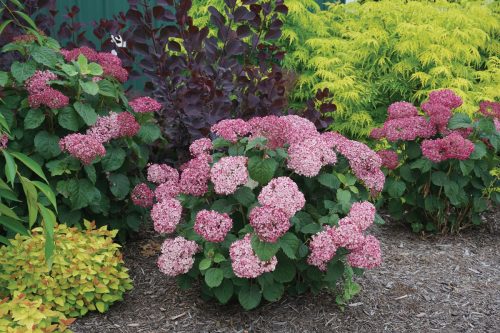
Key Factors to Consider:
Smooth hydrangeas (H. arborescens) are one of the first species to bloom, starting in late spring to early summer in warmer climates and midsummer in cool climates. They grow in zones 3-8 and the cooler your zone, the more sun they will thrive in. In the warmest zones, they will need some afternoon shade.
Because they bloom on new wood (the current season’s growth), these are some of the best hydrangeas to grow if you live in a cold climate or in an area that experiences late spring cold snaps. They are also great for people who like to cut their hydrangeas back in late fall or early spring, and for people who like to use hydrangeas as cut flowers. That’s because there is no risk of accidentally cutting off the flower buds during those times of the year.
Smooth hydrangeas grow easily in average garden soil with average to consistent moisture. They do appreciate well-drained soil with a slightly acidic to neutral pH, but are quite adaptable. Their flower color is not dependent on soil chemistry, so if you buy a pink smooth hydrangea, it will not turn blue in acidic soil.
Pairing Ideas:
Pictured above are three Invincibelle Mini Mauvette® smooth hydrangeas with Double Play® Candy Corn® spirea to the left, Winecraft Black® smokebush behind, and Lemony Lace® elderberry in the rear right. This combination will work best in full sun in zones 3 through 6, but would appreciate at least a few hours of afternoon shade further south.
Five more suggested companion plants for smooth hydrangeas:
- Coral bells (Heuchera)
- Reminiscent® roses
- Pinpoint® false cypress (Chamaecyparis)
- Sedges like ‘Evergold’ Carex
- Yarrow
Companion Plants for Bigleaf Hydrangeas (Hydrangea macrophylla)
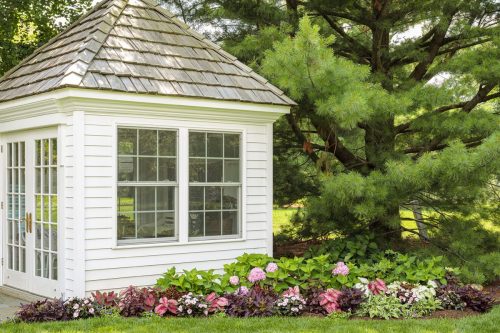
Key Factors to Consider:
Bigleaf hydrangeas (H. macrophylla) are the stars of the garden in midsummer in zones 5-9, when their large, mophead flowers bloom in shades of pink, blue or lavender depending on your soil’s pH. Reblooming varieties will produce a second show of flowers again in late summer.
Because they set flower buds on old wood for the following year, it’s better not to trim bigleaf hydrangeas at all except to remove dead branches. Trimming them down won’t make them shorter, it will just eliminate flowers.
This species of hydrangea thrives in consistently moist, rich, acidic soil. If you have neutral or alkaline soil and want to have blue hydrangeas, follow the advice in this article. As with smooth hydrangeas, the further north you live, the more sun bigleaf hydrangeas can take. If you live in the south, they will require afternoon shade. Bigleaf hydrangeas are not recommended for arid climates since the plants would become desiccated too quickly there.
Pairing Ideas:
Pictured above is a newly planted garden in part shade with bigleaf hydrangeas used as a backdrop. Within two to three years, they will fill the bed fully and won’t need any companions. For now, the front of the bed is filled with annuals to provide summerlong color. Those used here include Heart to Heart® caladiums, SunPatiens® impatiens, Hippo® polka dot plants, ColorBlaze® coleus and wishbone flowers.
Five more suggested companion plants for bigleaf hydrangeas:
- Painted ferns like ‘Crested Surf’ or ‘Ghost’
- Clematis
- Luminary® tall garden phlox
- Rainbow Rhythm® daylilies
- Jazz Hands® Loropetalum
Companion Plants for Mountain Hydrangeas (Hydrangea serrata)
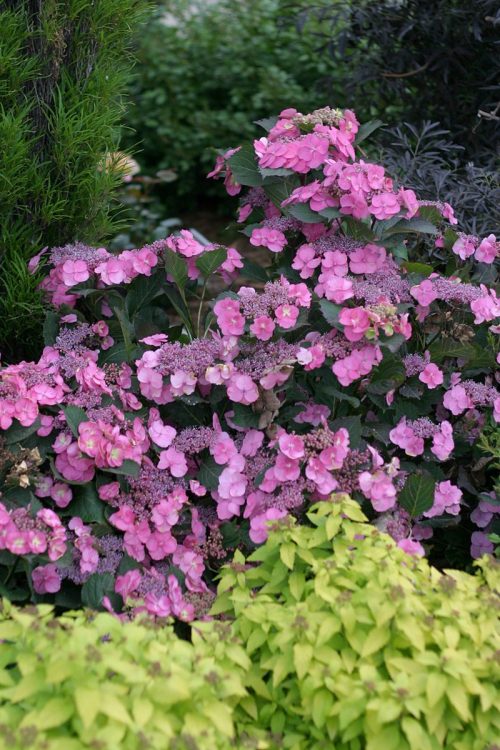
Key Factors to Consider:
Mountain hydrangeas (H. serrata and H. macrophylla x serrata hybrids) grow much like their bigleaf hydrangea cousins, blooming in midsummer with pink or blue flowers depending on the soil’s pH. However, most bear lacecap style flowers like you see in the picture above instead of the ball-shaped blooms of bigleaf hydrangeas. The fertile flowers in the center of each blossom are a delight for pollinating bees.
Because they are native to the mountains of Japan where the temperatures are much colder, mountain hydrangeas have evolved to have very durable, cold hardy buds and stems. Gardeners in zone 4 will appreciate that mountain hydrangeas are typically one zone hardier than bigleaf types.
Some mountain hydrangeas bloom in both old wood and new wood. They’ll grow in climates as warm as zone 9 where the season is long enough to enjoy a second round of blooms. As with bigleaf hydrangeas, it’s better not to trim mountain hydrangeas at all except to remove any dead branches. Trimming them down won’t make them shorter, it will just eliminate flowers.
The warmer your zone, the more afternoon shade mountain hydrangeas will need. Like bigleaf hydrangeas, mountain hydrangeas also thrive in consistently moist, rich, acidic soil. They are not recommended for arid climates.
Pairing Ideas:
Pictured above is Tuff Stuff® mountain hydrangea with shorter Double Play® Gold spirea planted in front. Creating a backdrop for the hydrangea is Fine Line® Rhamnus on the left and Black Lace® elderberry on the right. If this pairing was facing north, the taller shrubs would provide some afternoon shade for the hydrangea, which would make it work in warmer zones. In cooler climates, this pairing could face either north or south.
Five more suggested companions for mountain hydrangeas:
- Coneflowers (Echinacea)
- Tres Amigos® abelia
- Foamy bells (Heucherella) or coral bells (Heuchera)
- Upscale™ bee balm
- Prairie Winds® hardy fountain grass or Graceful Grasses® annual fountain grass
Companions for Panicle Hydrangeas (Hydrangea paniculata)
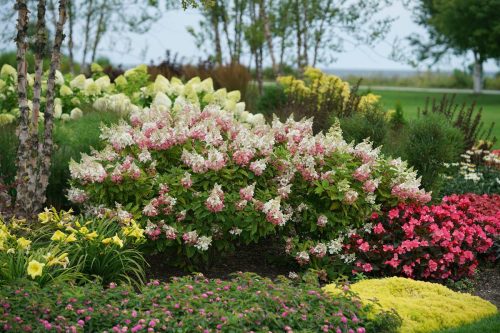
Key Factors to Consider:
Panicle hydrangeas (H. paniculata) round out the season with their showy, cone-shaped blooms which open creamy white and then blush to pink and red shades. Depending on which cultivar you grow, you could see the first blooms as early as midsummer, though most will be in their prime from late summer into fall. They bloom on new wood, so there’s no risk of cutting off flower buds if you prune them in late fall or early spring.
Panicle hydrangeas are the most sun tolerant species, thriving in full sun as far south as zone 7. The further north you live, the more sun they’ll prefer. They are cold hardy in zones 3 through 8. Panicle hydrangeas will also grow well in part sun, but will bloom far less prolifically in full shade, especially if you live in a cold zone 3 or 4.
Like their smooth hydrangea cousins, panicle hydrangeas grow in any well-drained soil with average moisture. They may struggle in soil that is moist or wet all the time. This opens them up to a wide range of companions, as you can see in the photo above. Because they are later bloomers, it’s good to pair them with annuals or earlier blooming perennials and shrubs to bring color to the space throughout the whole season.
Pairing Ideas:
Pictured above is PINKY WINKY PRIME® Hydrangea backed by ‘Limelight’ panicle hydrangeas. You can see that Pinky Winky started to bloom earlier than ‘Limelight’ because its flowers have already started their transition from white to pink. To the left are ‘Going Bananas’ daylilies with annuals planted in front including Luscious® Royale Cosmo lantana, Lemon Coral® sedum and Surefire® Rose begonias.
Five more suggested companions for panicle hydrangeas:
- Prairie Winds® switch grass (Panicum)
- Rock ‘n Grow® autumn stonecrop
- Ninebark
- Rose of Sharon
- Butterfly bush
Companions for Oakleaf Hydrangeas (Hydrangea quercifolia)
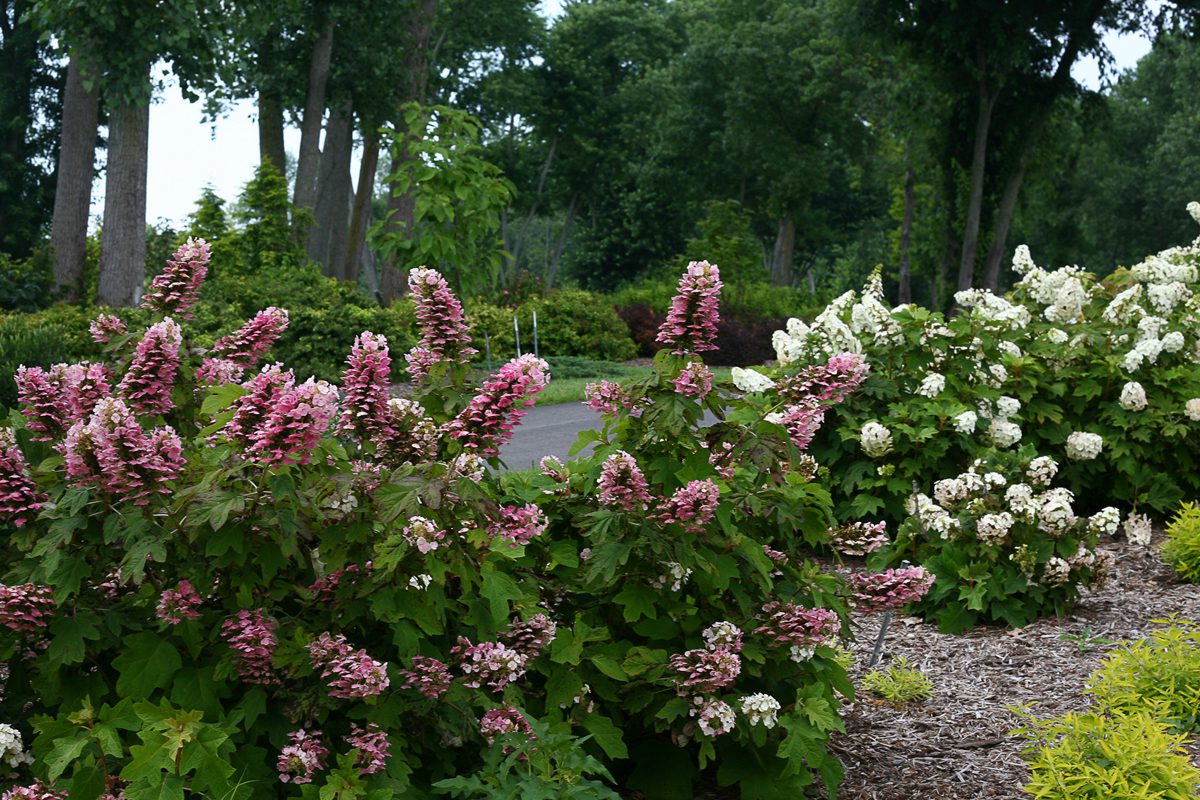
Key Factors to Consider:
Oakleaf hydrangeas (H. quercifolia) are often called “woodland hydrangeas” since they are the most shade tolerant species. They look right at home under a canopy of tall trees or planted in the shadow of a hedge or fence. However, our Gatsby® oakleaf hydrangeas will also grow in partial to full sun in cooler climates, which makes them one of the most versatile hydrangeas. They are hardy in zones 5 through 9 and will require afternoon shade in the warmest zones.
Rich, moist, well-drained soil, like the kind you’d find on a woodland floor, is ideal for oakleaf hydrangeas. However, many people report that they can handle some root competition and average moisture once they are established. Because of their large, broad, oak-shaped leaves, it’s best not to plant them on an exposed, windy site.
This species of hydrangea is the slowest to mature, especially if planted in shade, so it’s a good idea to fill the space around it with perennials that can be moved as needed as the hydrangeas mature. Annuals also make great fillers. Since oakleaf hydrangeas bloom in late spring to early summer, you could choose complementary early blooming companions or plant something that will bring color to the space later in the season.
Pairing Ideas:
You can see from the picture above that oftentimes, the best companions for oakleaf hydrangeas are tall shade trees like oak, hickory or pine. Shallow rooted maple trees would not be a good match since they would rob all the moisture from your hydrangeas. Shallow rooted groundcovers like pachysandra or ajuga can be grown around their base.
Five more suggested companions for oakleaf hydrangeas:
Companions for Cascade Hydrangeas (Hydrangea hybrid)
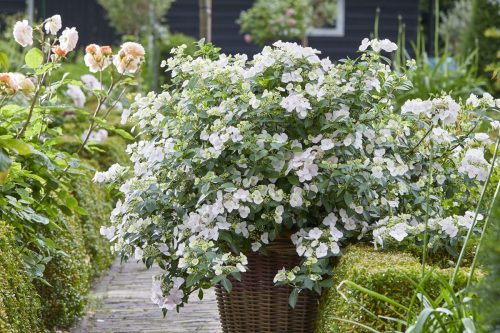
Key Factors to Consider:
Fairytrail Bride® cascade hydrangea is a completely unique form with stems that become long and trailing over time as the plant matures. In early summer, bright white, lacecap blossoms line the stems for a dramatic display. Because of its unique qualities and beauty, it’s best to pair Fairytrail Bride® with simple plants that play a supporting role.
This type of hydrangea blooms on old wood, so it is best suited for more mild climates in zones 6 through 9. If you live someplace with very cold winters or where late spring cold snaps occur regularly, this hydrangea is not the best choice for you. Avoid pruning except to remove any dead branches.
Plant your cascade hydrangea in rich, moist, acidic to neutral soil and apply a 2 to 3 inch layer of mulch around its roots to keep the soil cooler during the summertime. Though it can tolerate full sun in the cooler ends of its hardiness zones, this hydrangea will need some afternoon shade in warm climates.
Pairing Ideas:
In cooler zones 6 and 7, your Fairytrail Bride® hydrangea should be able to handle full sun as long as the soil is kept moist. There, roses, agapanthus and boxwood or holly make beautiful garden companions as shown in the picture above. This pairing would work just as well if the hydrangea were planted in the ground rather than in a container.
Five more suggested companions for cascade hydrangeas:
- Pyracomeles
- Perfecto Mundo® reblooming azaleas
- Steady As She Goes® gardenia
- ‘Heaven Scent’ Jacob’s ladder
- Brunnera
We’ve only just scratched the surface here with all the beauty you can create in your landscape with hydrangeas. Browse our entire perennial and shrub offerings, or explore our Hydrangea board on Pinterest.

2 thoughts on “What Should I Plant with My Hydrangeas?”
Very timely article. I’ve been thinking about what to plant with my Little Lime for its first summer. It is in a container on a NE facing balcony, and gets good early morning sun. Its container is actually the sunniest spot I have, the former successful home to petunias and calibrachoa (and one year, a single tomato plant). I was planning to plant calibrachoa around the hydrangea, but now I’m thinking the hydrangea will block out any available sun in that container, and maybe I should actually go with a shade annual. Thoughts?
Well written, excellent information. Timed perfectly. Like and agree with the companion planting suggestions. Keep up the good work!